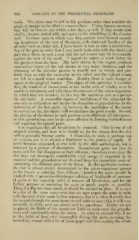Page 972 - My FlipBook
P. 972
982 DISEASES OF THE PERIDENTAL MEMBRANE. :
tooth. Tlic pieces may be left in this position rather than mutilate the
gingival margin in the effort to remove them. If they become necrosed,
they nill be tlirown out witliin a few days, or will, if they retain their
vitality, become united with, and assist in the rebuilding of, the alveolar
wall. In those cases in which very deep pockets have formed extend-
ing lengthwise of the root of the tooth, with thickened borders of the
alveolar wall on either side, I have found it best to raise a semicircular
flap of the gum in order that I may reach both sides with the chisel and
pare them down in such a way that the soft tissues may lie in smoothly
against the root of the tooth. I regard the chisel as much better for
this purpose than the burr. The burr driven by the engine produces
unnecessary injury of the soft tissues in very many instances, and the
trimming of the alveolar process is usually not so evenly and per-
fectly done as with the excavator or the chisel and the injured tissues
are left in a much worse condition. Besides^, there is more danger of
injury to the gingival border. The object of this operation is twofold
first, the removal of tissues sunk so low in the scale of vitality as to be
unable to recuperate, and with them the removal of the micro-organisms
by which they are invaded ; in this way the operation acts as a power-
ful antiseptic. A reasonable degree of mutilation of the subjacent tis-
sues acts as a stimulant and invites the formation of granulations for the
restoration of the lost parts ; if, however, the mutilation of the tissues
be carried too far, the injury will overbalance the good results. Second,
the placing of the tissues in such position as to obliterate all interspaces,
so that granulations may be the more effective in forming reattachments
and repairing the injured parts.
It is important that all blood-clots be removed. This is true of all
surgical wounds, and here it is doubly so, for the reason that the clot
will so generally become septic. A bloot-clot, as such, is perhaps not
an irritant, yet it is always a hindrance to the process of repair. It
never becomes organized, as was held by the older pathologists, but is
removed by a process of absorption. Granulations grow out into its
mass, and the clot disappears as they advance ; therefore, even when the
clot does not decompose, considerable vital energy is expended in its
removal and the granulations are diverted from the immediate work of
connecting the diiferent parts of the lesion. In this particular instance
the clot is almost always decomposed by the micro-organisms present
in the tissues or entering from without ; therefore the parts should be
washed with a peroxide-of-hydrogen solution of bichloride of mercury
(1 grain to the ounce) in orcler to remove all blood-clots, and for the
furtlier purpose of rendering the parts as nearly aseptic as possible.
Then, if a flap has been raised, it should be stitched in place. It is only
in a few of the more acute cases that we may expect the parts to unite
with the root of the tooth by first intention, biit it is often desirable that
the wound through the gum tissue should unite at once ; this it will very
generally do if the parts are placed Avell in apposition. If they are not
so placed, the fluids of the mouth are liable to wash away the granula-
tions and considerably delay the union. In order to prevent this, I am
in the habit of first, after thoroughly drying the parts, covering the
immediate wound Avith a bit of tissue-paper and then coating the whole


